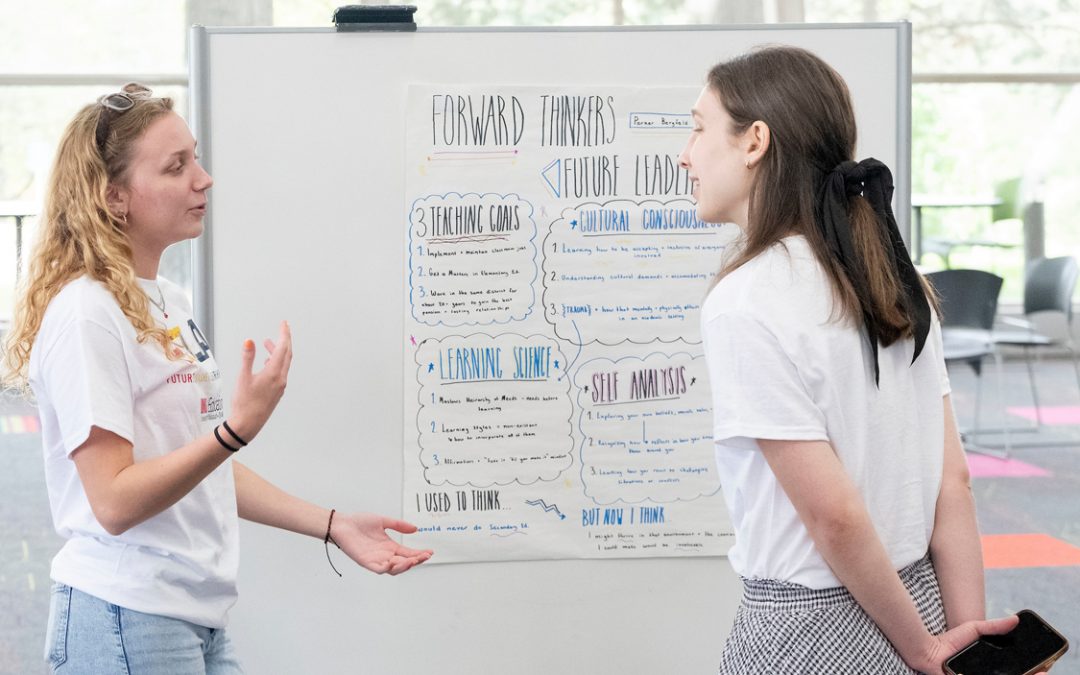
Tracy Pacini’s clinical scholarship project, “Benzodiazepine Reduction Program in a Psychiatric Mental Health Setting,” focused on reducing prescriptions of benzodiazepines at a federally qualified health center. In just a few months, her efforts had significant results, and Pacini found a 16.9% reduction of long-term prescriptions. (Photo by August Jennewein)
Popping a Valium, Xanax, Klonopin or other variant of the anti-anxiety medication class of benzodiazepines seems familiar and, by extension, safe due to their omnipresence in movies, TV and daily life.
Yet despite the cultural reputation of benzodiazepines, also known as benzos, the medications aren’t as benign as they might appear.
“With benzodiazepines, you have to look at the risk versus the benefit,” said Tracy Pacini, a psychiatric mental health nurse practitioner at a federally qualified health center in Granite City, Illinois, and a December Doctor of Nursing Practice graduate and adjunct faculty member at the University of Missouri–St. Louis.
Since 2015, the three-time College of Nursing alumna has worked to care for underserved patients. She’s focused on child and adult mental health care and has worked with medication assisted treatment for patients detoxing from opioids, heroin and alcohol; the residential crisis unit; and treating individual patients. She has seen firsthand the potential detrimental effects of benzodiazepines.
Weaning patients off of benzodiazepines became a passion for Pacini, and when it came time to pick a clinical scholarship project for her DNP, she decided to focus on this issue. The result, “Benzodiazepine Reduction Program in a Psychiatric Mental Health Setting,” is an education program designed to help providers taper patients off benzodiazepines. In just a few months, her efforts had significant results, and Pacini found a 16.9% reduction of long-term prescriptions.
The problem and a potential crisis
The problem with benzodiazepines is that they’re addictive and often prescribed inappropriately for long-term use. In September 2020, the Federal Drug Administration added a boxed warning “to address the serious risks of abuse, addiction, physical dependence, and withdrawal reactions.”
Though benzodiazepines have powerful short-term uses, they aren’t the standard treatment for long-term conditions, and prescribing them can make providers uncomfortable and frustrate patients trying to wean away from them.
“It’s hard to get patients off of them,” Pacini said. “They’re addictive, and people build tolerance and dependence. Then you have patients that are taking both benzodiazepines and opioids, and it is contraindicated because both drugs depress the respiratory function and can possibly cause death.”
Dependent patients who run out of pills are at risk for seizures, psychosis and hallucinations and comas. For those with mental illness, benzodiazepines have an increased likelihood of causing cognitive decline and other mental issues.
Overprescribed drugs can also end up for sale on the street, where they are impacting the opioid crisis and may be poised to become a crisis of their own. Pacini notes that they show up in the drug screenings of patients who come in for addiction treatments such as Suboxone or Vivitrol.
The program
Tamping down on benzodiazepines isn’t as simple as switching patients’ medications to something like a selective serotonin reuptake inhibitor antidepressant.
“It’s a hard conversation to have with patients who feel like they’re on a medication that’s working, that’s giving them relief from their anxiety,” Pacini said. “I wasn’t worried about getting providers on board. I was worried about patients accepting this.”
Accordingly, Pacini decided to tackle the issue from a patient education angle. She compiled provider recommendations from sources such as the Veterans Affairs guidelines and used evidence-based practice materials on tapering off benzodiazepines to create a pamphlet and flyers. After feedback from her peers, she also wrote a script that providers could use to bring the issue up to patients.
For the duration of her project, the providers distributed educational materials around the clinic and during every patient visit. The nurses also mailed them out to patients.
Pacini and her peers focused on incremental progress and had patients sign a controlled substance agreement to use the same pharmacy for prescriptions in order to avoid dangerous interactions between benzodiazepines and other medications, such as opioids.
“We worked with patients,” Pacini said. “It wasn’t like we said, ‘We’re cutting you off.’ That’s not what we wanted to do. That’s not safe, either. We kept talking about it every visit. I think overall, it went really well.”
The providers also worked to get patients on other non-habit-forming medications, such as hydroxyzine or SSRIs, and alternative treatment options, such as cognitive behavioral therapy or dialectical behavioral therapy, and mindfulness techniques. Some patients only tapered off the medication without replacements.
But that the process isn’t easy.
“There were some patients that had a lot of stressors and their symptoms were increasing, like anxiety and depression, when we were taking them off,” she said. “That’s where we go really, really slow. Some patients had withdrawal or rebound anxiety, and so we stopped the taper, and said, ‘OK, we’ll stop it for this month, and then we’ll continue to work on it.’”
The results
Every month, Pacini examined the total number of benzodiazepine prescriptions as a percentage of total scripts and the number of long-term benzodiazepine scripts for the four providers, hoping to find a reduction of 10%.
By the end of her project, Pacini’s overall reduction was 2.85%, but long-term benzodiazepine prescriptions were down 16.9%. She believes that those numbers could have been even larger if not for some of the project’s unavoidable limitations, such as the short term and working on it during the coronavirus pandemic, which reduced the number of times they saw patients.
Still, seeing that huge drop in prescriptions felt really good. But Pacini isn’t finished.
She hopes next to take the educational program beyond the four providers she worked with to the whole organization. Then, long-term, Pacini would like to get a no-benzo policy in place or a limiter on how they’re prescribed for short-term use only.
“Sometimes, I don’t have the energy to give all the information again, but I know that it’s the best thing for the patient,” she said. “But you just give the information to the patient, and it sits with them, and they really do it on their own. When patients have completely discontinued the benzodiazepine, they’re proud of themselves. I’ve had patients say, ‘Don’t ever give me that stuff again, that was so hard to get off.’”














